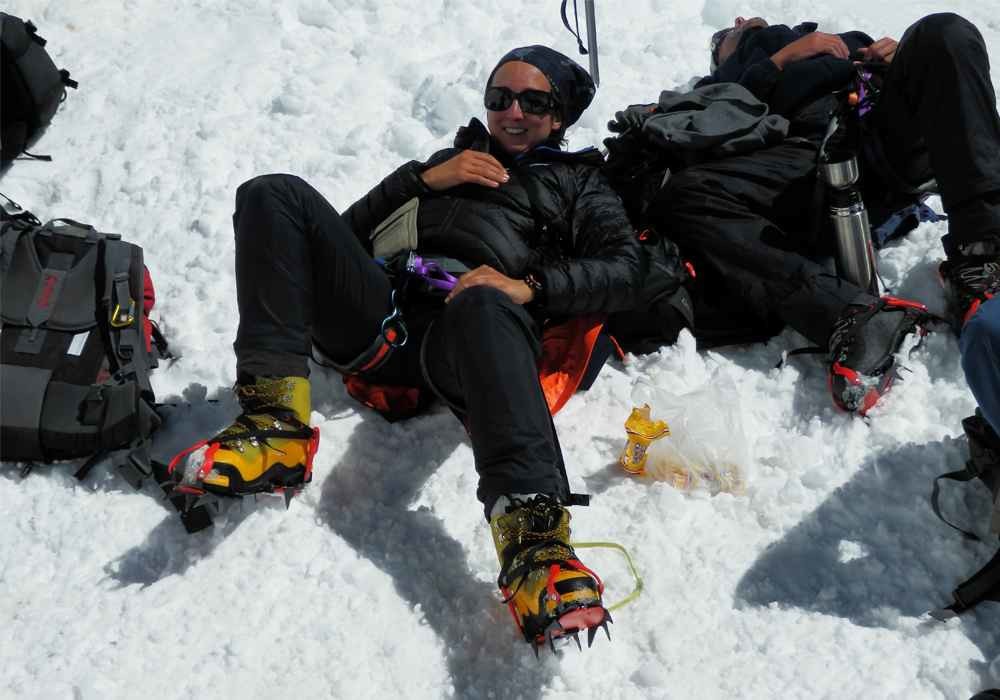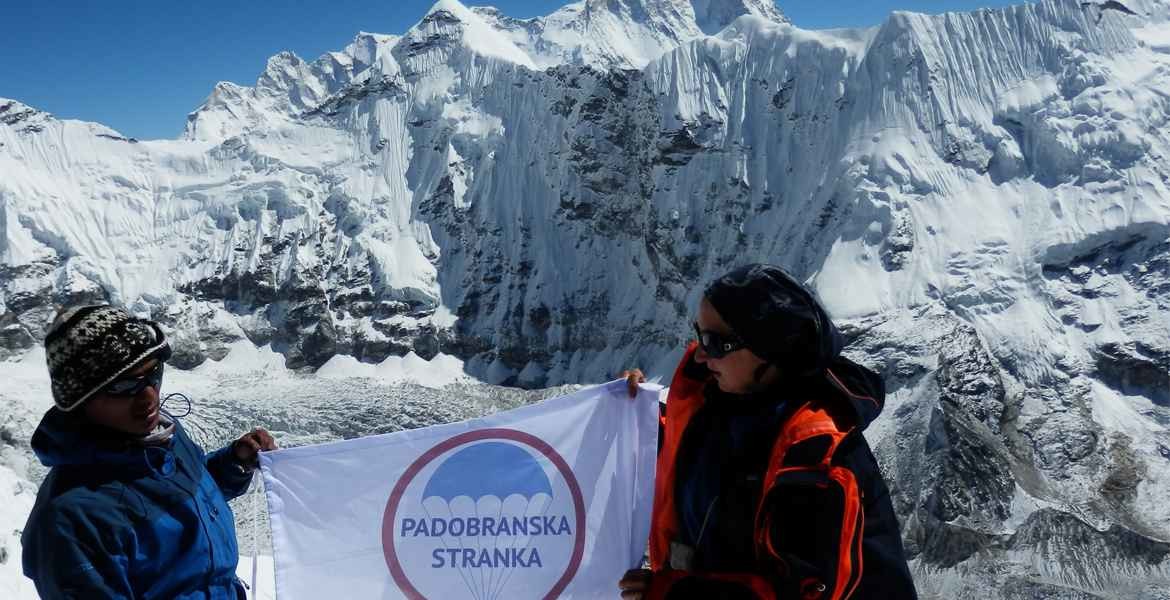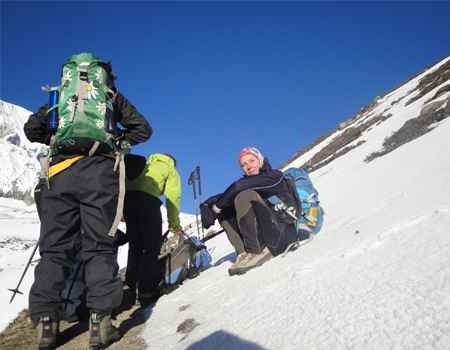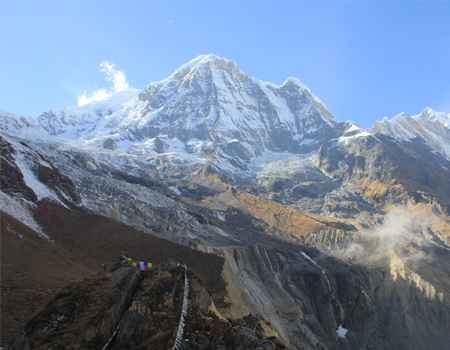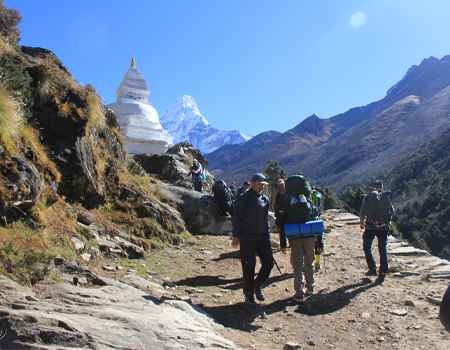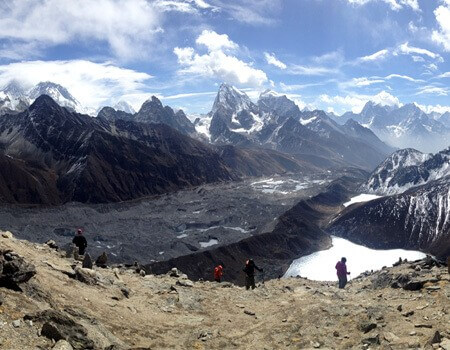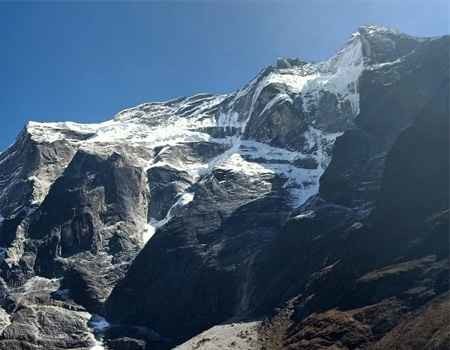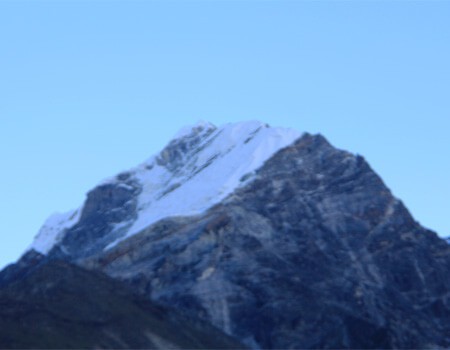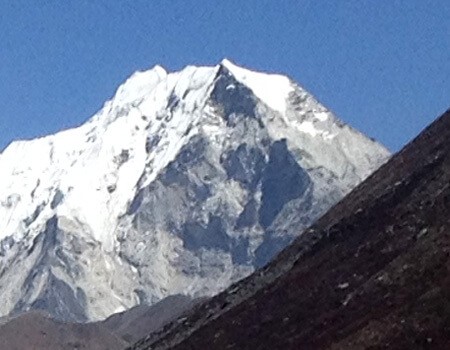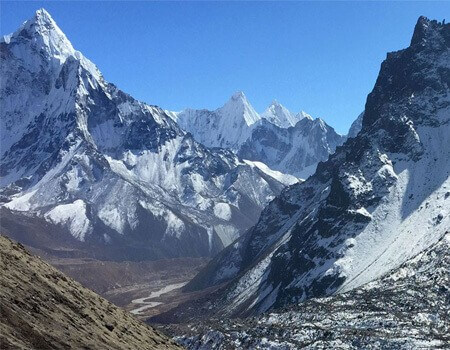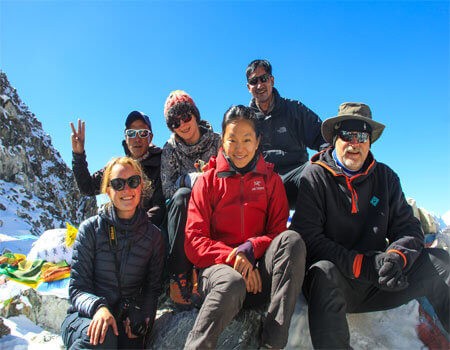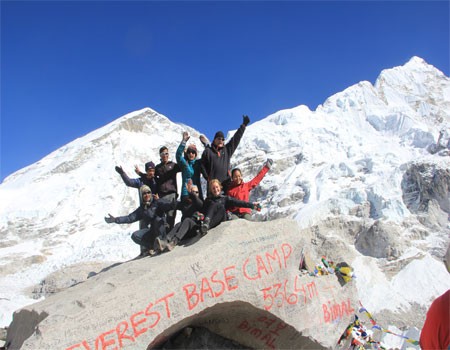Island Peak stands majestically at 6,189 meters (20,305 feet) in Nepal's Everest region. It offers one of the most accessible and rewarding Himalayan climbing experiences to climbers. The optimal seasons for attempting Island Peak are spring (March to May) and autumn (September to November), when stable weather conditions, clear skies, and manageable temperatures create ideal climbing conditions. Understanding the seasonal variations is crucial for planning a successful ascent of this spectacular peak.
The best time to climb Island Peak is during the pre-monsoon (spring) and post-monsoon (autumn) seasons. Generally speaking, you want to climb Island Peak in the spring or the autumn, specifically from March to the middle of May, and then from September to mid-November. These peak seasons provide the best conditions for both trekking and views.
Spring (March to May) and autumn (mid-September to October) are the periods when the weather in the Himalayan region remains stable, making them perfect for adventure activities. The spring season is a significant time for expeditions above 8,000 meters in the Everest region and the broader Nepali Himalayas so you can expect a large crowd of trekkers on the trails.
Spring is the busiest time for the Island Peak, so keep your seat safe by booking with us now!
Spring (March to May)
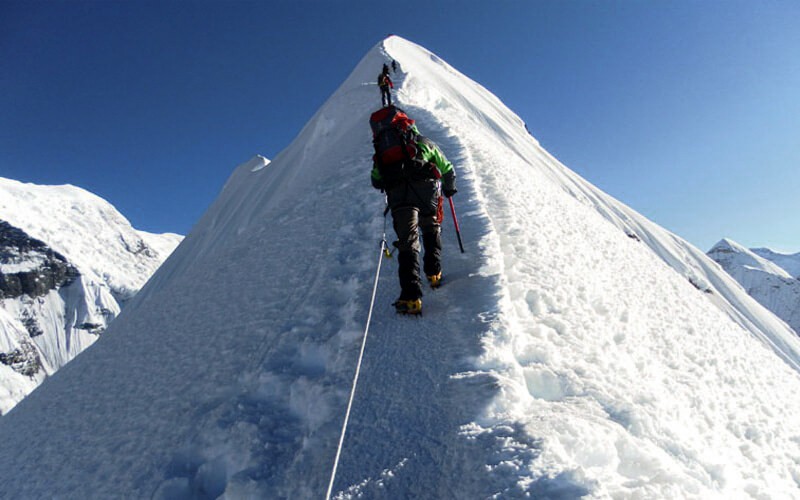
Climbers are about to reach the summit
Festival in Spring
Spring coincides with several vibrant Nepalese festivals that add cultural richness to the climbing experience. Mahashivaratri, dedicated to Lord Shiva, typically occurs in February or March, drawing thousands of devotees to temples throughout Nepal. Buddha Jayanti, celebrating the birth, enlightenment, and death of Lord Buddha, falls in April or May, marking an especially sacred time in the Buddhist regions of the Everest area. The spring season also brings Bisket Jatra, the fantastic chariot festival of Bhaktapur, and Holi (Fagun Purnima), the festival of colours that transforms valleys with vibrant celebrations.
Perks and Difficulties in Spring
Spring offers exceptional climbing conditions with stable weather patterns and clear skies that provide excellent visibility of the surrounding peaks. The season is renowned for its stunning natural beauty, as the trekking route is distinguished by breathtaking vistas of mountains, lush woods, vivid meadows, and blossoming rhododendrons. The trails become adorned with vibrant flora, creating an enchanting atmosphere with blooming wildflowers and thriving plant life.
However, spring also presents specific challenges. You may not have the entire facility to yourself, as this period attracts the highest number of climbers to Island Peak. The increased crowd levels can lead to shared experiences and lively atmospheres on the trails, creating a sense of camaraderie among climbers. However, accommodations and paths can become busy. Additionally, April also marks the Nepali New Year, which can contribute to the festive but crowded conditions.
Temperature in Spring
Spring temperatures create favourable climbing conditions while remaining manageable for properly equipped mountaineers. In March, temperatures can range from -10°C (14°F) at night to 10°C (50°F) during the day. By May, the mercury hovers around 5°C (23°F) at night and reaches 15°C (59°F) during the day. The weather will be sunny from 4,000 meters and above throughout the entire spring season, with temperatures ranging from roughly 15-17°C during the day to -10°C at night.
April offers pleasant weather conditions at Island Peak, with nighttime temperatures gradually rising to around -5°C (23°F), while daytime temperatures stay from 10°C (50°F) to 15°C (59°F). The progressively warming temperatures make April particularly attractive, as the weather becomes relatively stable by April, and the temperature becomes warmer than that of March.
Autumn (September to November)
Festival in Autumn
Autumn coincides with Nepal's most significant festivals, creating an extraordinary cultural backdrop for climbing Island Peak. Dashain, one of the most significant festivals in Nepal, celebrates the triumph of good over evil and typically falls in September or October. This 15-day festival involves rituals, family gatherings, and traditional celebrations throughout the country. Tihar, also known as the "Festival of Lights," follows Dashain and is celebrated over five days to honour deities, animals, and familial bonds. These festivals offer climbers the opportunity for deep cultural immersion by participating in the vibrant festivities of October.
Perks and Difficulties in Autumn
Autumn is widely regarded as the crown jewel of seasons and the ideal time to conquer Island Peak. The perfect time of year to climb Island Peak is said to be in the fall, with warm, pleasant weather, a lack of clouds, unobstructed views of the mountains, and little precipitation. November marks the end of the monsoon season, which typically brings minimal rainfall and reduces the risk of heavy snowfall or rain.
The post-monsoon clarity provides breathtaking views of the surrounding peaks, including Everest, Lhotse, Nuptse, and Ama Dablam. The crisp, cool air enhances the clarity of these panoramic vistas, creating a surreal backdrop for the ascent. Autumn also offers crisp, fresh air and clear skies starting from mid-September, providing unobstructed views of the mountains.
However, autumn presents some challenges. While autumn is also a popular time for trekking and climbing, there may be more climbers on the mountain and along the trail; it tends to be slightly less crowded than spring. Fewer people are on the trails, making it an excellent option for those seeking optimal weather with reduced crowd levels in November.
Temperature in Autumn
Autumn temperatures provide excellent climbing conditions with the weather ranging from 5°C (41°F) to 15°C (59°F) during the day and dropping to between -5°C (23°F) and -20°C (-4°F) at night. The temperature in November at lower altitudes ranges from 5 to 15°C (41 to 59°F), gradually decreasing as climbers ascend to higher altitudes.
During the autumn months, temperatures are cool but bearable, with daytime temperatures ranging from 10°C to 15°C at lower altitudes. However, they become colder at higher elevations, especially in the evenings and mornings. The average temperature ranges from 7 °C to 15°C during this season. Late autumn can be extremely cold, and trekkers can even expect a light snowfall by the end of the month, with temperatures dropping as low as -10°C.
Weather conditions for Island Peak
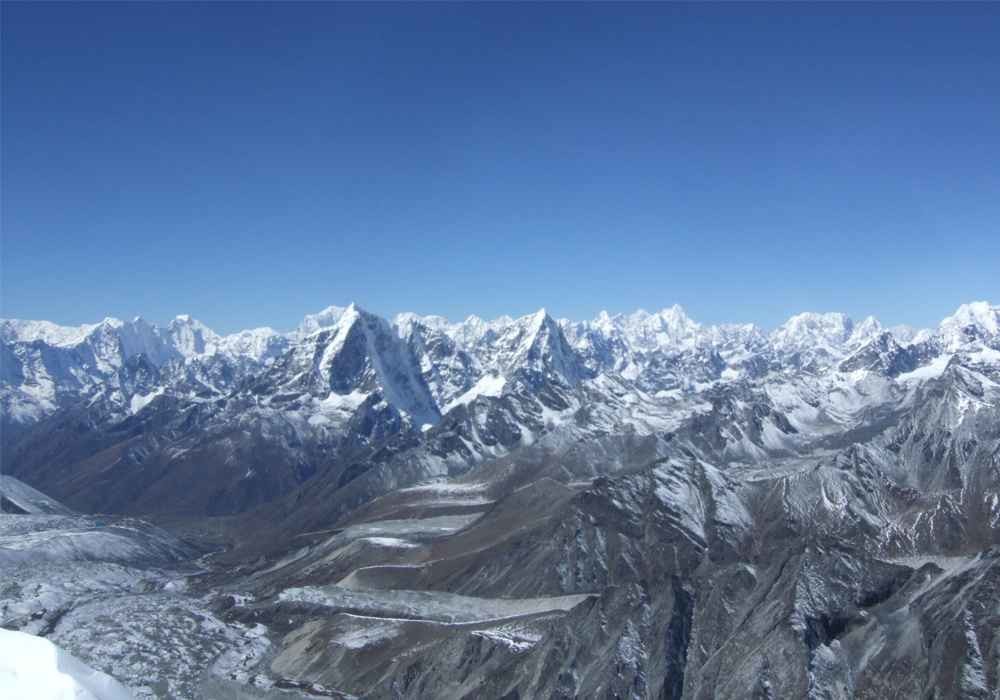
Mountain view from the Island Peak summit
Island Peak's weather conditions vary dramatically with the seasons, significantly impacting climbing success and safety. The weather in the Everest region is primarily defined by the monsoon and post-monsoon seasons, with the best weather for a safe and enjoyable climb being when it's dry, stable, and not too cold.
At the summit, the temperature never rises above freezing – generally, it's -36°C in winter and -19°C in summer. The extreme altitude means that climbers must contend with snow and ice conditions throughout the year, making proper equipment and timing essential for success.
Clear skies and visibility
Clear skies and excellent visibility are hallmarks of the optimal climbing seasons. Autumn is widely regarded as the peak climbing season in Nepal, including Island Peak, with the weather conditions generally stable, clear skies, and excellent visibility. The skies over the Everest region are typically clear and stable during autumn, providing climbers with optimal visibility and breathtaking views of the surrounding peaks.
Spring offers relatively stable weather conditions, characterized by clear skies and minimal snowfall. The stable weather and clear visibility provide optimal conditions for mountaineers to undertake their ascent. During these ideal seasons, climbers can expect good visibility for trekking and climbing activities, making it an optimal time to attempt the summit of Island Peak.
Stable weather
Weather stability is crucial for safe Island Peak climbing, and the optimal seasons provide the most predictable conditions. Spring offers relatively stable weather conditions, characterized by clear skies and minimal snowfall. The weather tends to be clearer during autumn in Nepal, and this period provides the best weather and climbing conditions.
During the optimal climbing months, weather patterns are stable, with minimal precipitation and low chances of snowfall compared to other seasons. A stable weather window enables a smoother ascent and descent, thereby enhancing the overall climbing experience. However, climbers must remember that the weather in the Everest region is unpredictable, and conditions on the mountain can change rapidly.
Favourable trail conditions
Trail conditions significantly impact the Island Peak climbing experience, varying dramatically from one season to the next. During spring and autumn, the trails are relatively dry and stable, making navigation easier and safer for climbers. The trails during these seasons are accessible and relatively easy to navigate, with stable weather contributing to safer and more favorable climbing conditions.
In contrast, monsoon conditions create challenging trail situations. The trails become wet and slippery, making climbing conditions more difficult. Due to significant rainfall, the trails are muddy and hazardous during the summer months. Rain and clouds often reduce visibility, increasing the risk of avalanches and landslides.
Crowd levels on Island Peak
Understanding crowd dynamics helps climbers plan their Island Peak experience according to their preferences for solitude or social interaction. Spring attracts the highest number of climbers to Island Peak, with the pleasant weather, clear skies, and blossoming landscapes drawing many trekkers. April and October coincide with the best weather conditions, attracting a higher number of climbers and trekkers.
Autumn also brings many climbers, but it tends to be less crowded than spring. By November, fewer people are on the trails, making it an excellent option for those seeking optimal weather with reduced crowd levels. During the monsoon season, the number of climbers is at its lowest, as heavy rain and challenging trail conditions deter most people from venturing out.
Temperature at high altitude
High-altitude temperatures on Island Peak present significant challenges that climbers must prepare for throughout the year. At Island Peak's elevation, temperatures remain consistently challenging, with the summit never rising above freezing. The temperature in locations over 6000 meters is highly variable.
During optimal climbing seasons, nighttime temperatures at high camps can drop significantly. In spring, nighttime temperatures can range from -5°C to -10°C at higher elevations, while in autumn, temperatures can drop to between -5°C (23°F) and -20°C (-4°F) at night. Winter conditions are incredibly harsh, with nighttime temperatures potentially falling as low as -20°C (-4°F) or lower.
Monsoon season (June to August)
The monsoon season is the most challenging time for climbing Island Peak, with conditions generally unsuitable for a safe ascent. Summer (June to August) brings the monsoon season to Island Peak, accompanied by increased rainfall and cloud cover. June marks the onset of the monsoon season in Nepal, bringing warmer temperatures and occasional rain showers to the region.
During the monsoon months, daytime temperatures can reach up to 25°C (77°F), with nighttime temperatures ranging from 5°C (41°F) to 10°C (50°F). However, this season is marked by frequent showers and overcast skies, from drizzles to heavy downpours. The core monsoon months are July and August, during which 63% of monsoon rains are typically observed.
The combination of rain and cloud cover may limit visibility, obstructing panoramic views of the surrounding Himalayan peaks. From June to August, the summer season is feasible but not ideal for ascending Island Peak due to significant rainfall, making the trails muddy and hazardous. It can also be dangerous at times, due to natural disasters such as avalanches and landslides.
Winter climbing (December to February)
Winter climbing on Island Peak presents extreme challenges suitable only for highly experienced mountaineers. The months of December, January, and February are considered winter as well as off-season months for Island Peak climbing. Freezing temperatures and heavy snowfall characterise the Island Peak in winter.
During the winter months, the weather is frigid and freezing, with lower sections (below 4,000 m) experiencing a minimum temperature of -5°C and a maximum temperature of roughly 12°C. At higher elevations above 4,000 m, the minimum temperature is around -15°C, and the highest temperature is near 8°C. Due to the heavy snow and extremely cold (-40°C) winds at the peak, climbers often refrain from attempting the climb between December and mid-February.
However, with proper preparation, suitable equipment, and assistance from a qualified climbing guide, winter climbing is possible, especially in December. December is the ideal month for those who enjoy trekking in solitude and prefer peaceful terrain. Winter climbing is still possible, but is recommended only for individuals with extensive mountaineering experience, approaching the level of professional athletes.
Peak climbing season in Nepal
There are thousands of climbers from all around the world in Nepal every year, when the country has the most favourable weather conditions. The peak climbing seasons in Nepal are spring (March to May) and autumn (September to November), when weather conditions are most stable and predictable. These seasons offer clear skies, moderate temperatures, and manageable trekking conditions.
The spring season is chosen for most of the 8000+M expeditions in the Everest region, meaning climbers will likely encounter many expedition teams heading for Everest during April and May. The spring climbing season is also the best time for Everest Climbing, so along the way, you will likely encounter expedition teams.
Autumn represents the peak climbing season in Nepal, with September, October, and November being the ideal months for mountaineering adventures. This period attracts a high volume of trekkers and climbers due to the favourable weather conditions and spectacular post-monsoon clarity.
Post-monsoon clarity
Post-monsoon clarity represents one of the most spectacular aspects of autumn climbing in Nepal. The weather in Nepal during autumn is the most clear and offers the best conditions for climbing. September marks the beginning of autumn and follows the monsoon period, when the end of the monsoon season clears the trails of dust and refreshes the environment.
Post-monsoon clarity unveils breathtaking views of the surrounding peaks, making autumn an ideal time for spectacular mountain photography and panoramic vistas. The crisp, cool air enhances the clarity of these scenic vistas, creating a surreal backdrop for the ascent. October and November are particularly known for clear skies and excellent visibility.
The landscapes become vibrant with lush greenery, and streams, waterfalls, and lakes are fully replenished, offering spectacular views of water throughout Nepal. This clarity makes autumn particularly appealing for climbers seeking the best photographic opportunities and clearest mountain views.
Trekking conditions
Trekking conditions vary dramatically across seasons, significantly impacting the overall Island Peak climbing experience. During optimal seasons, trekkers can expect well-defined trails, stable weather, and favourable navigation conditions. The trails during spring and autumn are accessible and relatively easy to navigate, with lower precipitation levels contributing to safer climbing conditions.
Spring trekking conditions offer the advantage of longer daylight hours, providing ample time to enjoy the scenery of the alluring Himalayan vistas. The favourable weather conditions, marvellous mountain views, and safer trails make spring one of the most favoured times for Island Peak climbing.
Monsoon trekking conditions present significant challenges, with wet and slippery trails making navigation difficult and posing potential dangers. During this time, expect muddy and treacherous routes due to heavy rain, which can make summer trekking unproductive due to the weather conditions. Winter trekking conditions require extreme preparation, as many lodges and tea houses are closed due to harsh weather, making camping a necessity.
Acclimatization period
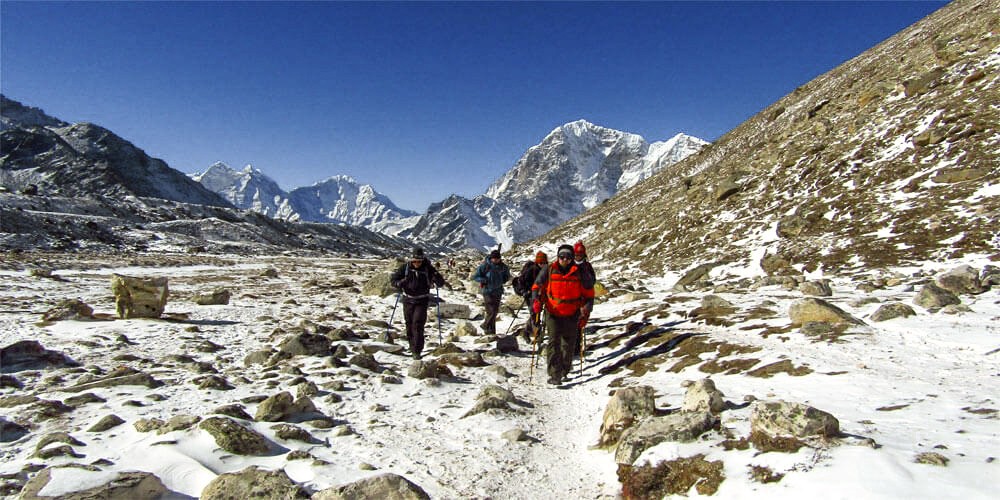
Trekking to Everest Base Camp and Kala Patthar for acclimatizing before climbing Island Peak
Proper acclimatisation is crucial for Island Peak climbing success and represents one of the most important safety considerations. Acclimatisation refers to the process of adjusting to higher altitudes to minimise the risk of altitude sickness and ensure a successful climb. The human body can adapt to moderate hypoxia at elevations of 17,000 ft (5,200 m) but requires time to do so.
Gradually increasing sleeping altitude is the most effective way to prevent altitude illness, with staged ascent and preacclimatization to hypoxia reducing the risk of altitude illness. Island Peak climbing itineraries typically include multiple acclimatisation days at locations like Namche Bazaar and Dingboche. Spend another couple of days acclimatising in and around Dingboche, then head to Gorak Shep, very near Everest Base Camp.
Unacclimatized people are at high risk of acute altitude illness when ascending above 8,200 ft (2,500 m). Still, acute mountain sickness can occur as low as 6,500 ft (2,000 m). The Wilderness Medical Society recommends avoiding ascent to a sleeping elevation of 9,000 ft (2,750 m) in a single day and ascending at a rate of no greater than 1,650 ft (500 m) per night once above 9,800 ft.
Safety and technical challenges
Island Peak presents significant technical challenges that distinguish it from simple trekking peaks. Island Peak is technically demanding, requiring basic mountaineering skills such as using crampons, ice axes, and fixed ropes. The climb features steep sections that require the use of fixed ropes, where climbers encounter steep, vertical terrain while securely attached to the ropes for safety.
The final ascent involves crossing a glacier, which presents challenges such as crevasses and icy surfaces. Climbers must be proficient in using crampons and ice axes, as these tools are vital for safety on glacial terrain. The ascent includes sections of steep snow and ice slopes, rocky terrain, and the use of crampons, ice axes, and ropes.
Weather can change in minutes in the Himalayas, with blue skies rapidly giving way to whiteouts. The climb features a 100-meter (328-foot) ice headwall with slopes reaching up to 45 degrees. Prior experience in high-altitude trekking and some level of technical training are recommended to navigate these challenging sections safely.
Summit views
The summit of Island Peak offers some of the most spectacular panoramic views in the Himalayas. Island Peak not only offers an enjoyable climb but also provides some of the most stunning scenery in the Everest region of the Himalayas. Seen from the summit, the giant mountains Nuptse (7,879m), Lhotse (8,501m), Lhotse Middle Peak (8,410m), and Lhotse Shar (8,383m) make a semicircle in the north.
The views of Makalu (8475m) to the east, Baruntse and Amadablam to the south, add more charm to climbing Island Peak. From the summit, climbers enjoy spectacular views of Everest, Lhotse, Makalu, and many 7,000m+ peaks. In clear weather, you can also see Mt. Makalu (8,475m) in the east.
The summit provides climbers with optimal visibility and breathtaking views of the surrounding peaks, including Everest, Lhotse, Nuptse, and Ama Dablam. Island Peak affords impressive views of Everest and other giants from the summit, making the challenging ascent tremendously rewarding.
Permit and logistics
Island Peak climbing requires several permits and proper logistics planning for a successful expedition. To climb Island Peak, you need to obtain three permits: the Nepal Mountaineering Association (NMA) Permit, Sagarmatha National Park Entry Fee, and the Local Area Permit. The Nepal Mountaineering Association classifies Island Peak as a Group B trekking peak.
Island Peak climbing permit costs vary by season: the Spring Season (March-May) costs USD 250 per person, the Autumn Season (September-November) costs USD 125 per person, and the Winter/Summer Season costs USD 70 per person. Sagarmatha National Park Entry Permit costs NPR 3,000 per person (approximately USD 25). The entrance permit for Khumbu Pasang Lhamu Rural Municipality costs NPR 3,000 per person (approximately USD 25).
NMA doesn't provide permits for Island Peak climbing to individual climbers and requires a government-registered local travel agency with professional climbing guides. All these permits are included in most package costs when booking with reputable trekking companies.
Fewer crowds in late autumn
Late autumn provides an excellent opportunity for climbers seeking optimal weather conditions with reduced crowd levels. By November, fewer people are on the trails, making it an excellent option for those seeking optimal weather with reduced crowd levels. The number of trekkers decreases as the autumn season progresses, making late autumn particularly appealing to those who prefer solitude.
While late autumn can be extremely cold, with trekkers even expecting a light snowfall by the end of the month, temperatures can drop as low as -10 °C, the reduced crowds and stable weather make it attractive for experienced climbers. November presents a captivating opportunity for climbers seeking to conquer Island Peak with favourable weather conditions and fewer crowds.
The crisp, cool air and clear skies of late autumn enhance the clarity of panoramic vistas, creating optimal conditions for photography and mountain appreciation, without the bustle of peak-season crowds.
Blooming rhododendrons (spring)
Spring's blooming rhododendrons create one of the most spectacular natural displays during the Island Peak climbing season. From March to May, the trekking route is characterized by breathtaking vistas of mountains, lush forests, vibrant meadows, and blossoming rhododendrons. The rhododendrons and other wildflowers make the entire atmosphere enchanting during springtime.
Rhododendrons typically bloom from early spring to early summer, with the peak blooming season for most varieties being March to May. Spring highlights include rhododendrons in various colours, with wave after wave of colours from pale pink, lavender, and yellow to bold red, orange, and purple competing for attention. The weather typically provides favourable conditions during the rhododendron blooming season, with stable and inviting weather conditions ensuring clear visibility.
The vibrant flora and blooming wildflowers add a beautiful natural backdrop to the Island Peak climbing experience, with the combination of spectacular mountain views and colourful rhododendron displays creating unforgettable scenic beauty. Species rhododendrons are typically found high in the mountains and consider the mild spring conditions optimal for blooming, making the Island Peak trek particularly spectacular during this season.
Conclusion
Island Peak climbing success depends heavily on choosing the right season, with spring and autumn offering the optimal combination of weather stability, manageable temperatures, and spectacular scenery. While each season presents unique advantages and challenges, understanding these seasonal variations allows climbers to make informed decisions based on their experience level, crowd preferences, and specific climbing objectives. Whether attracted by spring's blooming rhododendrons and longer daylight hours or autumn's post-monsoon clarity and fewer crowds, proper timing ensures the best possible Island Peak climbing experience.
Ready for the Island Peak Adventure? Please don't be late to book it!
